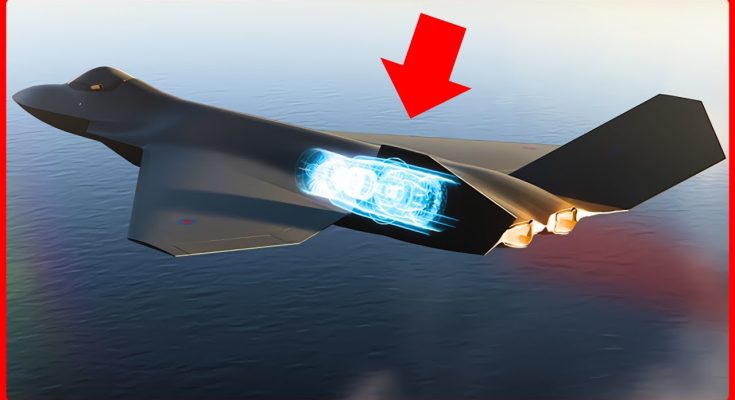In 2025, the United Kingdom made headlines with a highly classified test of its new 6th generation fighter jet, a leap forward in both technology and military strategy. Though details remain scarce due to the secretive nature of the project, sources within the defense community have confirmed that the UK has successfully tested this cutting-edge aircraft, which is poised to redefine the future of aerial combat. This new fighter jet promises to be a game-changer, with revolutionary features that will significantly enhance the UK’s air capabilities and rival other nations’ most advanced fighter programs.
Next-Gen Stealth and Low Observability
A cornerstone of the UK’s 6th generation fighter is its stealth technology. While the F-22 Raptor and F-35 Lightning II set high standards for stealth, the UK’s new fighter takes these features to the next level. The jet incorporates advanced radar-absorbing materials (RAM) and adaptive shaping technology, which allows it to change its physical appearance to minimize its radar cross-section (RCS) even further. These innovations make it nearly invisible to enemy radar systems, rendering it undetectable by most current air defense systems. Additionally, its infrared signature has been reduced dramatically, making it far more difficult for heat-seeking missiles to lock onto it.
The fighter also features active camouflage, blending into its environment and enhancing its ability to operate undetected in hostile airspace. With these stealth improvements, the jet can operate in contested environments and evade detection, giving it a significant edge over adversaries with sophisticated radar and missile defense systems.
Autonomous Operations and AI Integration
Perhaps one of the most exciting advancements in the UK’s 6th generation fighter is the integration of artificial intelligence (AI) and autonomous systems. The jet is capable of performing many functions autonomously, such as advanced combat maneuvers, targeting, and mission planning. AI algorithms work in tandem with the pilot, assisting in decision-making and analyzing real-time battlefield data. This collaborative approach reduces the cognitive load on the pilot, allowing them to focus on higher-level strategies while the AI manages complex tasks.
Additionally, the fighter can operate semi-autonomously in certain scenarios, such as engaging low-priority targets, coordinating strikes, or executing evasive maneuvers when under threat. This autonomy ensures that the aircraft can adapt quickly to changing combat conditions, making it highly effective in dynamic environments.
Advanced Avionics and Sensor Fusion
The UK’s new fighter is equipped with a next-generation avionics suite that offers unprecedented situational awareness. The aircraft features sensor fusion technology, combining data from multiple sensors, including radar, infrared systems, and electronic warfare platforms. This fusion allows the pilot to have a comprehensive, real-time picture of the battlefield, including enemy aircraft, surface-to-air missile sites, and ground targets.
The 360-degree radar coverage is complemented by a distributed aperture system (DAS), providing the pilot with continuous tracking of all threats in their vicinity. These sensors enable the fighter to detect, identify, and engage targets with incredible precision, whether they are in the air or on the ground.
Multirole Capabilities and Weapons Systems
The 6th generation fighter is designed to be a true multirole platform, capable of executing a wide range of missions with ease. It can engage in air superiority, close air support, intelligence gathering, and precision strike operations. The jet is equipped with internal weapon bays to preserve its stealth profile while carrying a wide range of munitions, including hypersonic missiles, laser-guided bombs, and air-to-air missiles.
One of the standout features is its ability to carry and deploy hypersonic weapons, which travel at speeds greater than Mach 5. These weapons are capable of bypassing most current defense systems, enabling the fighter to strike high-value targets at exceptional ranges with unprecedented speed. The fighter’s direct energy weapons may also be incorporated, offering a futuristic method of engaging targets without traditional munitions.
Networked Warfare and Global Interoperability
The UK’s 6th generation fighter is built to seamlessly integrate into networked warfare environments. It can communicate and share data with other aircraft, drones, satellites, and ground-based assets in real-time, enhancing its effectiveness as part of a broader combat force. This interoperability ensures that the fighter can function in joint operations with allied forces, whether conducting strike missions or providing air superiority.
The ability to tap into a global information network allows the fighter to receive intelligence updates instantly, enhancing its capability to adapt to rapidly changing tactical situations. This makes the aircraft more versatile, capable of operating in both isolated and collaborative combat environments.
Conclusion
The UK’s secretly tested 6th generation fighter jet is set to become a pivotal element of its military strategy, with its combination of unmatched stealth, autonomous capabilities, next-gen avionics, and multirole flexibility. While many of its specific features remain classified, it is clear that this fighter will redefine aerial combat in the coming decades. Rival nations, particularly those with advanced air defense systems, now face a fighter that is not only stealthy and highly agile but also capable of adapting to the future of warfare with AI-driven technologies and networked combat capabilities. This 6th generation fighter will give the UK a strategic edge in any potential conflict, ensuring it remains at the forefront of modern military aviation.



